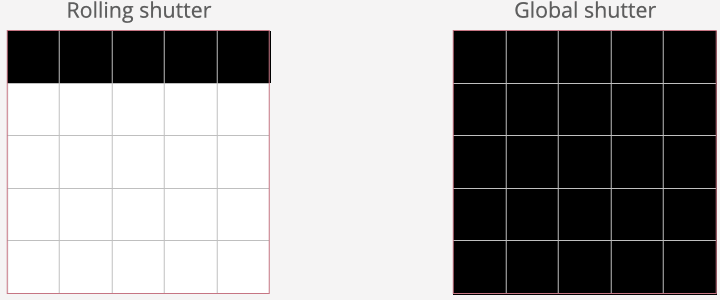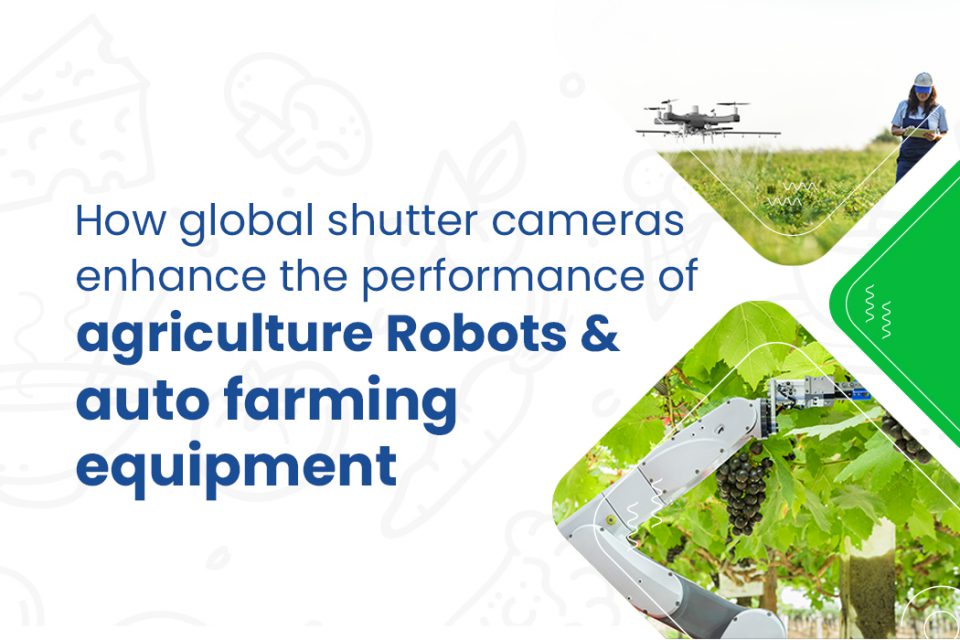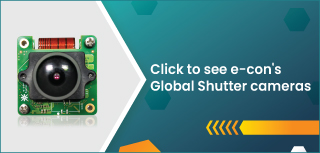Agricultural robots help farmers automate many mundane and time-consuming tasks to improve productivity and quality of their produce. Owing to the advantages these automated systems can offer, the market for agricultural robots is growing at a fast pace. According to marketsandmarkets, the global agricultural robots market size is expected to grow from USD 4.9 billion in 2021 to USD 11.9 billion by 2026, at a CAGR of 19.3%. Types of these agricultural robots and auto farming equipment include harvesting robots, automated weeders, plowing robots, milking robots, drones, etc.
Most of these systems need to have a camera in them to enable automated operations (To learn in detail about why using a camera is vital in auto farming, please visit Embedded vision in auto farming – here is why camera selection is vital). But, when a robot or the object to be captured is moving fast, a rolling shutter camera need not meet the imaging requirements. In such a case, a camera with global shutter efficiency is recommended. In this article, we look at how global shutter cameras can enhance the performance of agricultural robots and auto farming systems.
What are rolling shutter and global shutter?
Before we even look at how global shutter cameras improve agricultural robots’ performance, let us learn what rolling shutter and global shutter are.
In a rolling shutter camera, each pixel row is exposed one after the other. This leads to what is called a rolling shutter artifact, which is nothing but a form of distortion in the output image (Rolling shutter artifact should not be confused with motion blur. To know the differences between the two, have a look at Differences between rolling shutter artifacts and motion blur).
At the same time, in a global shutter camera, the entire frame is exposed at once allowing it to capture a complete scene in one go. This prevents rolling shutter effect from happening and helps to produce an exact replica of the scene to be captured. To learn more about the differences between rolling shutter and global shutter cameras and how to pick one for your application, please have a look at the article What are global shutter and rolling shutter? How to choose the one that fits the application? You could also watch the video below for a start.
Why global shutter for agricultural automation?
As discussed above, a global shutter camera captures a complete frame in one shot. Please have a look at the below representation to understand the concept better.

Capturing a frame all at once is particularly helpful when the vehicle or object is in fast motion.
For instance, let us consider an automated weeding robot. Be it for removing weeds and unwanted growth, or spreading pesticides, movement of the plants as well as the motion of the robot can cause challenges to reliable image capture. If we use a rolling shutter camera in this case, the robot might not be able to locate the exact coordinates of the weed. This will hugely impact the accuracy and speed of the robot, and might as well lead to the robot not being able to perform its desired task.
A global shutter camera comes to the rescue in this scenario. With a global shutter camera, an agricultural robot can locate the exact coordinates of a fruit or vegetable, identify its type, or assess its growth accurately.
Most popular embedded vision applications in auto farming where global shutter is recommended
While there are many camera based applications within auto farming, it is to be noted that not every application requires a global shutter camera. Further, in the same type of robot, some use cases would require a global shutter camera, while certain others might not. The need for a particular shutter type is defined entirely by the end application and the type of robot you are building. Also, we already discussed weeding robots in the previous section. So, here we look at some of the other popular auto farming use cases where a global shutter camera is preferred over a rolling shutter one.
Unmanned Aerial Vehicles (UAVs) or agricultural drones
Drones are used in agriculture for the purposes of plant counting, measuring crop density, calculating vegetation indices, determining water needs, etc. They help to continuously monitor crops from planting to the harvesting stage. While all drones do not need a global shutter camera, in cases where image capture has to happen when the drone is in fast motion, a rolling shutter camera might result in image deformations. For instance, NileCAM25 (Full HD GMSL2 color global shutter camera) from e-con Systems is a good fit for drones considering its global shutter efficiency and 15-meter cable support.
Agricultural trucks and tractors
Large agricultural trucks and tractors are used for various farm-related tasks such as transporting animal food, hauling grass or hay, pushing and pulling agricultural equipment, etc. With advancements in technology, many of these vehicles have started becoming autonomous and driverless. In manned trucks, cameras are typically part of a surround-view system that helps the driver get a 360-degree view of the vehicle’s surroundings to avoid collisions and accidents. In unmanned vehicles, cameras help in automated navigation by accurately measuring the depth of objects and obstacles. In both cases, a global shutter camera might be required if any object in the scene of interest moves fast enough making it not possible to capture the image using a normal rolling shutter camera.
Sorting and packing robots
These robots are used to sort and pack fruits, vegetables, and other produce from a farm. Some packing robots have to sort, pick, and pack static objects, in which case a global shutter camera is not required. However, if the objects to be sorted or packed are placed on a moving surface – say a conveyor belt – then a global shutter camera produces a better quality image output.
Conclusion
As discussed before, selection of the shutter type of a camera has to be done on a case to case basis. There is no one size fits all approach here. In a vast majority of agricultural use cases, a rolling shutter camera with a high frame rate, or just a normal rolling shutter camera should do the job. When you choose a camera or sensor, it is always recommended to take the help of an imaging partner who has experience in integrating cameras into agricultural robots and vehicles.
Cameras for auto farming from e-con Systems
e-con Systems comes with 18+ years of experience and expertise in embedded vision and camera solutioning. Its wide portfolio also comprises of cameras for auto farming which include global shutter cameras, cameras with IP-rated enclosures, GMSL cameras, 4K HDR camera, low light camera, etc. Here is a comprehensive list of all those camera systems
- STURDeCAM25_CUXVR: IP67 rated GMSL2 color global shutter camera for NVIDIA Jetson AGX Xavier
- NileCAM25: Full HD GMSL2 color global shutter camera module
- See3CAM_CU81: 4K HDR USB camera based on AR0821
- e-CAM83_USB – 4K High resolution HDR USB camera
- See3CAM_CU27: Sony STARVIS IMX462 ultra-low light USB camera
- NileCAM21: Full HD GMSL2 HDR camera with LFM
- See3CAM_CU22: Full HD HDR USB camera with LFM
- e-CAM22_CUXVR: Sony STARVIS IMX327 ultra-low light MIPI camera
- STURDeCAM20: IP67 rated Full HD GMSL2 HDR camera
Hope this article gave you a good understanding of why a global shutter camera is recommended for many auto farming applications. If you have any further queries, or are looking for help in integrating cameras into your auto farming system, please write to camerasolutions@e-consystems.com.

Gomathi Sankar is a camera expert with 15+ years of experience in embedded product design, camera solutioning, and product development. In e-con Systems, he has built numerous camera solutions for robots, industrial handhelds, quality inspection systems, smart city applications, industrial safety systems, and more. He has played an integral part in helping hundreds of customers build their dream products by integrating the right vision technology into them.





